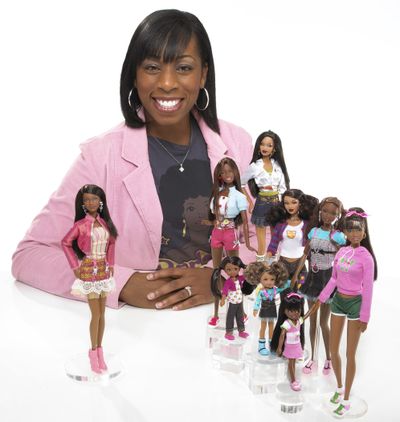New-look Barbie gets mixed reviews
While many are praising Mattel for creating black dolls, some contend toys still don’t address nagging beauty issues

Mattel has launched a new line of black Barbie dolls with fuller lips, a wider nose and more pronounced cheekbones – a far cry from Christie, Barbie’s black friend who debuted in the 1960s and was essentially a white doll painted brown.
The “So In Style” line, which hit mass retailers last month, features BFFs Grace, Kara and Trichelle, each with her own style and interests and a little sister she mentors: Courtney, Janessa and Kianna.
The dolls reflect varying skin tones – light brown, chocolate, and caramel – and Trichelle and Kianna have curlier hair.
Barbie designer Stacey McBride-Irby, who is black and has a 6-year-old daughter, says she wanted to create a line of dolls for young black girls that looked like them and were inspirational and career-minded. For example, Kara is interested in math and music.
“I want them to see themselves within these dolls, and let them know that black is beautiful,” McBride-Irby says.
Many black women are praising Mattel for its efforts. But some say the dolls with long straight hair are not “black enough” and do not address the beauty issues that many black girls struggle with.
In the black community, long, straight hair is often considered more beautiful than short, kinky hair.
Chris Rock highlights the issue in his new “Good Hair” documentary, which shows black women straightening their tight curls with harsh chemicals and purchasing thousand-dollar hair weaves.
“Why are we always pushing this standard of long hair on our girls?” asks Gail Parrish, 60, a playwright in Alexandria, Va., and a mother of four grown children. “Why couldn’t one of the dolls have a little short afro, or shorter braids or something?”
McBride-Irby says she originally designed all the dolls with long hair. Combing her Barbie’s long hair when she was a girl was the “highlight of my play experience,” she explains.
She was advised to create some dolls with curlier hair, so she did. There’s also a So In Style hairstyling set so girls can curl, straighten and style their dolls’ hair over and over. (It costs $24.99, more than a pair of dolls at $19.99.)
That is troubling to Sheri Parks, an associate professor of American Studies at the University of Maryland in College Park, because it actively involves girls in the process of straightening hair. She worries that it reinforces the message that there is something wrong with natural hair.
“Black mothers who want their girls to love their natural hair have an uphill battle and these dolls could make it harder,” Parks said in an e-mail.
Aside from the hair, some black women are concerned about the dolls’ thin frames.
Barbie, which celebrated her 50th birthday in March, has for years come under fire for promoting an unrealistic body image, with her long legs, tiny waist and large breasts.
While white girls also deal with body-image issues, Kumea Shorter-Gooden, co-author of “Shifting: The Double Lives of Black Women in America,” believes Barbie has a more negative impact on black girls.
They are already struggling with messages that “black skin isn’t pretty and our hair is too kinky and short,” she says.
Despite those complaints, Mattel seems to have gotten several things right.
Andrea Slaughter, 38, a mom of two in Newnan, Ga., says she likes how the designer highlighted values that are critical in the black community, such as education and mentoring.
Sheila Adams Gardner, 41, a mother of three in Woodbridge, Va., praises the varying skin tones. She says when her daughter was 4, she became very self-conscious about being lighter than everyone else in her family.
“She has always had African-American dolls, but rarely dolls with skin like her own,” Gardner says. “Often the lighter dolls were Hispanic or Indian.
“It was very heartwarming to look at a series of African-American Barbies and hear my daughter, now 11, exclaim, ‘She looks like me!’ ”
Even Shorter-Gooden acknowledges the facial features “look like real black people.”
Mattel doesn’t release sales figures, but spokeswoman Michelle Chidoni says the dolls are resonating with girls of all colors and ages.
The line will be expanding next year with Rocawear clothing, and new dolls Chandra and her little sister Zahara, and Darren, who will have a little brother he mentors.